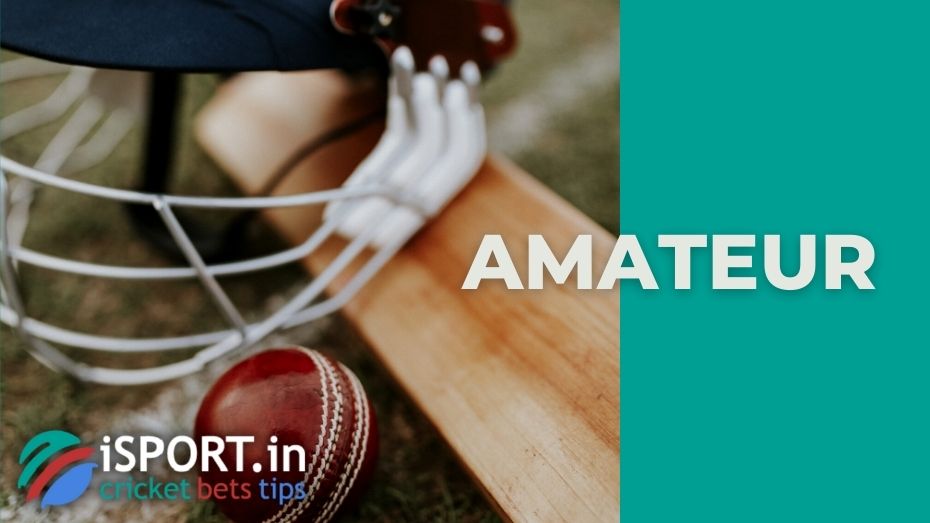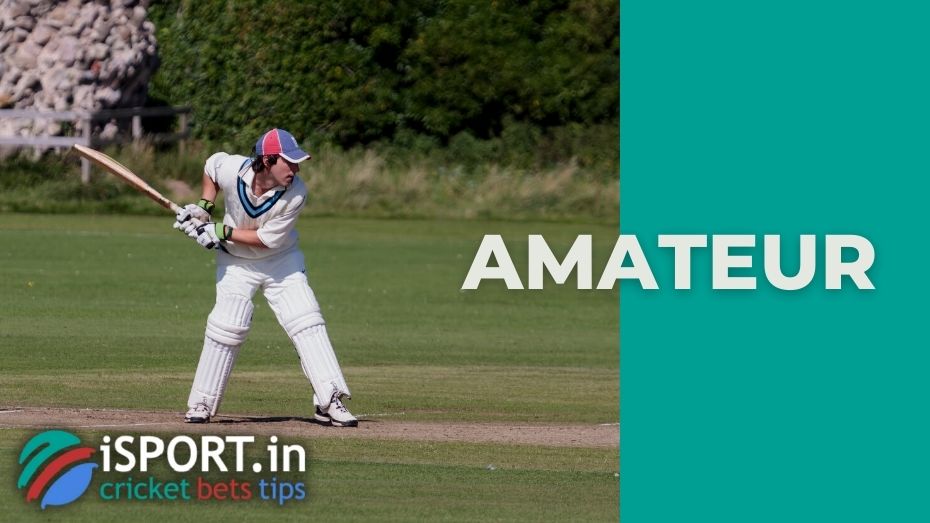Amateur

We continue our exploration of cricket terminology. Today, we focus on the word amateur in cricket – a term familiar to any sports enthusiast. Many play football, tennis and the same cricket at the amateur level. In cricket, the ball and bat can be picked up at almost any age, and there are examples when people enter the field at the age of 70.
Amateur In Cricket: The Basic Meaning
At the moment, any fan who actively plays this game can consider himself an amateur in cricket, regardless of whether they play casually with friends on the lawn or participate in local tournaments with prize money at stake. After finishing their professional careers, some cricketers also receive amateur status and play in the same teams with amateurs who have never been professionals.

Amateur In Cricket: First-Class In England
The first recorded mention of cricket in England dates back to 1597, in a court case where John Derrick testified about playing cricket with his friends on a plot of land in Guildford during his school years. At first, cricket was really children’s entertainment, but gradually the situation changed. More and more adults were getting involved in this game. By 1629, records show that noblemen were playing the game. However, at the time, recreational activities on Sundays were prohibited, with fines and arrests imposed for violations. There is a well-known case of the priest Henry Cuffin, who was brought to justice for playing on Sunday evening after prayer.
In the 17th and 18th centuries, the aristocracy viewed cricket as a gambling sport, akin to horse racing The fact is that bets were accepted on the results of the games, the size of which was considerable. At the same time, cricket fans rejoiced that this sport was able to overcome the social gap because initially, only commoners took to the field.
The distinction between amateur in cricket and professional in first-class English cricket lay primarily in rewards:
- Professional cricketers received a salary from their club, along with payments for tournament appearances and tours. Their travel and accommodation expenses were covered, and during the summer, they dedicated themselves entirely to cricket. In the off-season, they often took up temporary work.
- Amateur cricketers did not earn money for participating in tournaments, but organizers could compensate them for travel and accommodation costs. For many, cricket was a secondary activity alongside their primary profession, which led to frequent team changes. Over time, it became easier for athletes to combine their main job with playing cricket. This discipline was increasingly popular and respected in society, so employers hoped to increase the prestige of their organization.
English student associations played a crucial role in the development of the amateur in cricket. Tournaments were usually held during the holidays. Most often, students gathered in the summer – from July to September. High school students were also actively involved in such competitions. Schools and universities greatly influenced cricket’s growth, with the sport being widely played in prestigious institutions such as Oxford and Cambridge. There were constant competitions between schools and universities, as a result of which high-level players grew up.

Amateur In Cricket: Gentlemen vs Players Tournament
The Gentlemen vs Players tournament was first held in 1806, organized by Frederick Beauclerk. The competition featured two distinct teams: the Gentlemen, consisting of amateurs from the upper and middle classes, and the Players, composed of working-class professionals. From 1829 to 1962, this tournament became an annual event, serving as an opportunity for amateur in cricket to test their skills against professionals.
For the Players, the tournament was a chance to prove their abilities and earn a living, leading to a continuous rise in skill levels. Thus, the general level of cricket in England grew.
In the 19th century, the title of amateur in England testified to the high status of a person. Amateurs demanded separate dressing rooms for themselves and sometimes separate zones for entering the field. Gradually, teams began to appear at the national level, in which both professionals and amateurs played. At the same time, the captains in the teams were appointed not the actual leaders but the most popular players among amateurs. There are several similar examples in the history of English cricket:
- In the Yorkshire team of the 1920s, Wilfred Rhodes was often the de facto captain, though the official title was held by amateur players.
- In the 1930s, Wally Hammond deliberately switched from professional to the status of the amateur in cricket to become captain of the England national team in international competitions.

Amateur in cricket: Amateur Status Over Different Centuries
In 1642, during the English Civil War, the Long Parliament banned many public gatherings. While cricket itself was not outlawed, playing on Sundays remained prohibited. However, cricket’s popularity surged after the war, particularly in 1660, as noblemen returned home and played the game with their neighbors.
By 1694, the first monetary prizes were awarded to match winners. Charles Lennox, the 1st Duke of Richmond, was one of cricket’s earliest aristocratic patrons, promoting the sport at his estate in Sussex. At the end of the 17th century, this sports discipline became an integral part of the culture in many social groups in England – from the aristocracy to criminals. Historians believe that cricket helped solve many social issues. For example, G. M. Trevelyan compared the situations in England and France:
“If the French noblesse had been capable of playing cricket with their peasants, their chateaux would never have been burnt.”
In the 18th century, the influence of politicians on the amateur in cricket increased. Many dukes began to enter the field. In order to successfully play on bets, some famous people formed their own teams of the county class and led them. In 1727, the 2nd Duke of Richmond and Alan Brodrick drew up agreements regarding new match conditions, forming the basis for the first written Laws of Cricket in 1744 and 1774. In 1787, the Marylebone Cricket Club (MCC) was established by professional cricketer Thomas Lord, after whom the renowned Lord’s Cricket Ground is named.
In the 19th century, cricket began to be passed down from generation to generation in England. The second half of the 19th century is considered a golden period for cricket in this country. At this time, the Gentlemen vs Players tournament began to compete with the meetings of the North vs South teams.
The Abolition of Amateur Status
In 1887, the Marylebone Cricket Club announced that cricket had become “exceedingly fashionable, being much countenanced by the nobility and gentlemen of fortune”. This meant that it would be impossible for a well-known amateur in cricket to receive additional benefits in the Gentlemen vs Players tournament matches. Despite this, some amateurs received unofficial payments, leading to the term “shamateurism” – a blend of “sham” and “amateur.”
After the Second World War in England, there were social changes in society. The organizers of sports competitions realized that they could earn good money by professionalizing their teams. To do this, it was necessary to create completely professional teams. As a result, the division into amateur in cricket and professional was abolished in 1962.
The news about the cancellation of amateur status in England was perceived in different ways. Someone thought that a great era had passed, and some people thought it was high time to equalize the players’ rights.
